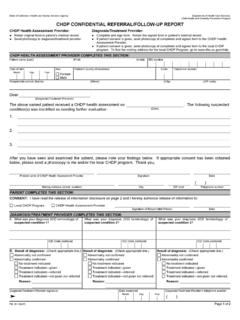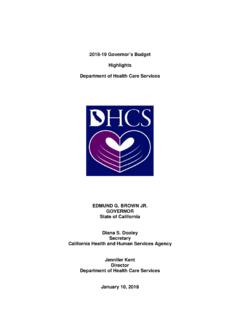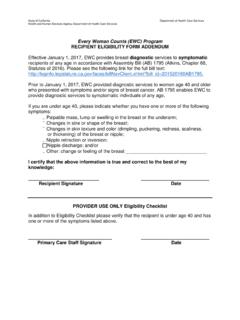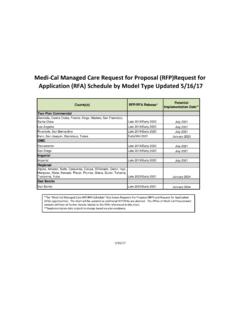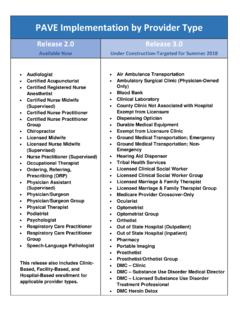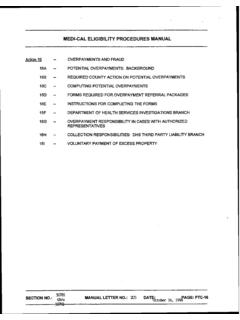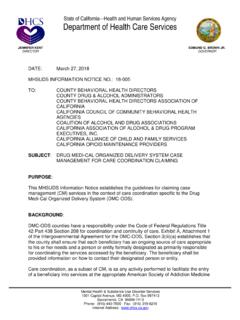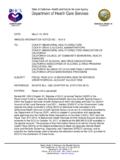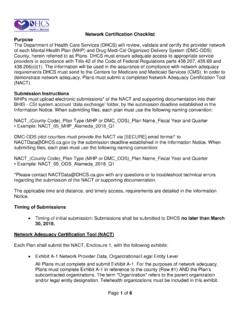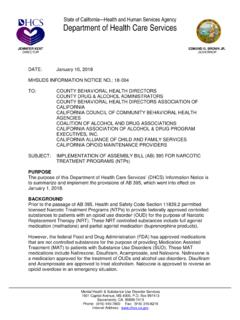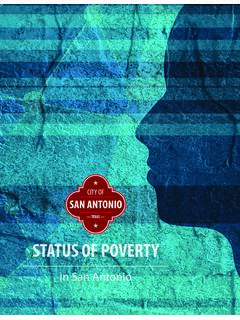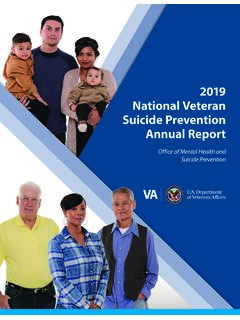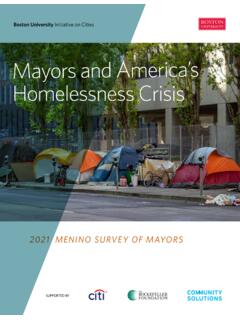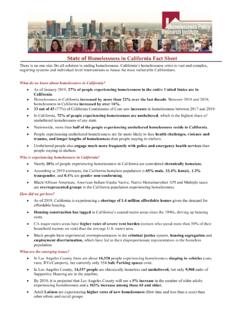Transcription of INTRODUCTION TO TRAUMA - INFORMED CARE - California
1 INTRODUCTION TO TRAUMA - INFORMEDCARES eptember 2019 1 TRAINING PURPOSE Provide basic information to health plan and community-based caremanagement entity (CB-CME) staff on TRAUMA - INFORMED care and directthem to resources for additional information The Department of Health Care Services (DHCS) recommends that allstaff supporting Health Homes Program (HHP) members receivetraining on TRAUMA - INFORMED care (Program Guide Appendix C) All communication with members must utilize TRAUMA - INFORMED carepractices (Program Guide Section VI)2 WHAT IS TRAUMA ? Individual TRAUMA results from an event, series of events, or set of circumstances that is experienced by an individual as physically or emotionally harmful or life threatening and that has lasting adverse effects on the individual s functioning and mental, physical, social, emotional, or spiritual well-being.
2 Source: Substance Abuse and Mental Health Services Administration (SAMHSA) 3 WHAT IS TRAUMA ? TRAUMA is relative Perception and response t o TRAUMA varies by individual TRAUMA is cumulative Traumatic experiences can be isolated events or can be compounded by repetitive TRAUMA throughout a lifetime TRAUMA is complex Exposure to TRAUMA and an individual s responses to it are complex and related to physical, social, and cultural factors 4 WHAT IS TRAUMA - INFORMED CARE? An organizational structure and treatment framework that involves understanding, recognizing and responding to the effects of all kinds of TRAUMA . Source: What is TRAUMA - INFORMED Care? Video 5 HOW TRAUMA - INFORMED CAREFITS INTO THE HHP All staff that provide HHP services should be trained in recognizingtrauma and providing TRAUMA - INFORMED care These staff include, but are not limited to: Care Coordinators HHP Directors Clinical Consultants Housing Navigators Community health workers6 HOW TRAUMA - INFORMED CARE FITS INTO THE HHP TRAUMA - INFORMED care should be provided to members through all HHP services: Assessment Health Action Plan development Health Action Plan implementation Care Coordinator, community health worker, and other care team interactions and communication with members 7 WHAT IS THE IMPACT OF TRAUMA ?
3 TRAUMA is prevalent Early TRAUMA has long-termconsequences TRAUMA complicates chronic diseasemanagement TRAUMA complicates behavioralhealth treatment TRAUMA and homelessness are oftencorrelated8 ADVERSE CHILDHOOD EXPERIENCESA dverse Childhood Experiences (ACEs) impact physical and psychological development: ACEs change brain and immune system function and can lead to detrimentalphysical and mental health effects decades in the future There is evidence that ACEs impact genetics, leading to intergenerationaleffects of exposure to TRAUMA In California , of adults report exposure to adverse childhoodexperiences* If a child experiences one ACE, there is an 85% chance of experiencing twoor more ACEs* Source: Let s Get Healthy California 2015 DataSource: ACEs 101 Fact Sheet9 ADVERSE CHILDHOOD EXPERIENCES RESEARCHO riginal Study - FelittiVJ, Anda RF, et al.
4 Relationship of childhood abuse and household dysfunction to many of the leading causes of death in adults: The Adverse Childhood Experiences (ACE) Study. American Journal of Preventive Medicine 1998;14:245-258 Hundreds of research articles since then have confirmed and expanded on the findings SAMHSA Short Video on ACEs 10 ACES AND CHRONIC DISEASER esearch shows that ACEs lead to chronic disease, such as: Emphysema Chronic bronchitis Autoimmune disease Diabetes Obesity Heart disease Stroke Cancer11 ACES AND BEHAVIORAL HEALTHR esearch shows that ACEs lead to higher risk of: Smoking Alcoholism Drug use Suicide attempts Depression Risky sexual behavior and STDs12 ADULT TRAUMA Chronic stress and TRAUMA exposure have the most significant impact onphysical and mental health Single traumatic events can have harmful physical and psychological effects Nearly all body systems are negatively affected by TRAUMA .
5 Gastrointestinal function Cardiovascular system Immune system Reproductive system Musculoskeletal system Neuroendocrine function Brain function Source: D Andrea W, Sharma R, et al. 2011. Physical Health Problems After Single TRAUMA Exposure:When Stress Takes Root in the Body 13 COMMUNITY TRAUMA TRAUMA can manifest at an individual or community level Communities experiencing high levels ofviolence, poverty, lack of infrastructure, andoppression can experience collectivetrauma in addition to personal trauma14 COMMUNITY TRAUMA Collective TRAUMA compounds the effects of individual TRAUMA Community TRAUMA and violence impacts the social environment, communityengagement and cultural norms Community TRAUMA can be related to the physical/built environmentincluding unsafe housing, lack of transportation, community displacement.
6 Orlack of opportunities for physical activity Community TRAUMA can be highly correlated with economic factors such aspoverty and inequity15 MITIGATING THE EFFECTS OF TRAUMA Neurological effects of TRAUMA can be modified Interactions with people who provide support and encouragement cancounter the harmful effects of TRAUMA Identification and intervention are key Health care providers can mitigate the effects of TRAUMA by: Implementing TRAUMA - INFORMED communications Identifying exposure to TRAUMA Providing appropriate resources and referrals16 SAMHSA S 4 R S OF TRAUMA - INFORMED CAREA TRAUMA - INFORMED program, organization or system: Realizes the impacts of TRAUMA and the need for TRAUMA - INFORMED care; Recognizes the signs and symptoms of TRAUMA ; Responds by incorporating TRAUMA - INFORMED practices throughout thesystem; and Resists re-traumatizationSource: SAMHSA s Concept of TRAUMA and Guidance for a TRAUMA - INFORMED Approach, 2014.
7 17 SAMHSA PRINCIPLES OF TRAUMA - INFORMED and support and self and , voice, and , historical, and gender issues18 WHAT DOES TRAUMA -INFORMEDCARE LOOK LIKE IN PRACTICE? Safety Traditional approach: A 25-year-old patient who has experienced sexual TRAUMA avoids appointments for her annual women s physical, which she knows will include a pelvic exam. Health center staff are concerned with scheduling and productivity. Interactions between patient and staff focus on the patient s history of missed appointments and late cancellations. TRAUMA - INFORMED approach: When making appointments that will involve potentially triggering services, such as pelvic exams, a few simple questions are added to the phone script.
8 Do you have a preference for a male or female provider? Is there anything we need to know to make your exam more comfortable for you? In this scenario, health center staff are signaling to the patient that she will be entering a safe environment and that staff and providers want to help her feel comfortable. 19 WHAT DOES TRAUMA -INFORMEDCARE LOOK LIKE IN PRACTICE? Trust and Transparency Traditional approach: A 35-year-old patient was sexually abused as a child and has never disclosed the events to anyone. He is offered a telehealth consult with a psychologist to discuss his anxiety and health center believes this will increase access to patient is hesitant because he is concerned about privacy and believes someone may walk in the room in the provider s office without his knowledge.
9 He declines the consult and forgoes a behavioral health consult until months in the future when an in-person appointment can be made. 20 WHAT DOES TRAUMA -INFORMEDCARE LOOK LIKE IN PRACTICE? Trust and Transparency (continued) TRAUMA - INFORMED approach: The patient is given a short handout about telehealth psychology consults, which addresses frequently asked questions about confidentiality and logistics. He is given an opportunity to speak directly with the behavioral health department before committing to an appointment. In this scenario, the health center staff are transparent about what the patient can expect during the consult and build trust by offering him an opportunity to reassure himself about the process.
10 21 WHAT DOES TRAUMA -INFORMEDCARE LOOK LIKE IN PRACTICE? Peer Support and Self-Help Traditional approach: A 50-year-old diabetic patient sees his provider once every 3 months and has the same conversation every patient pretends to be following his diet and exercise routine because he doesn t want to be patient grew up in an emotionally abusive household and still has a difficult time dealing with authority figures. TRAUMA - INFORMED approach: The patient is invited to be part of a diabetes education and support group where he interacts with other patients, learns some cooking and healthy living skills and is able to talk about how hard it is for him to follow his doctor s group facilitator gives him some tools to use when talking to his doctor that lead to setting smaller, more realistic goals.
